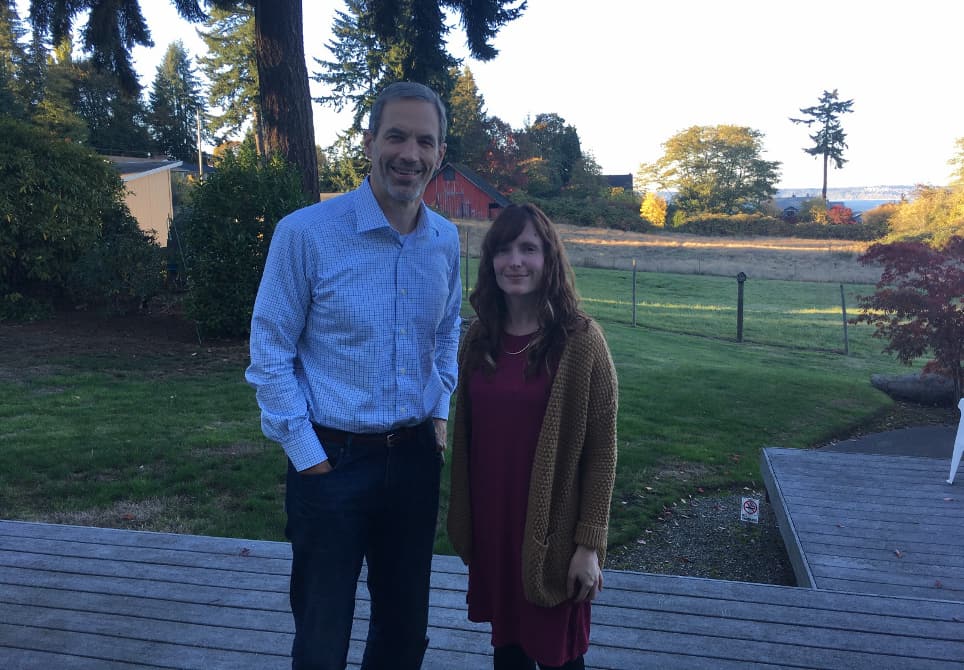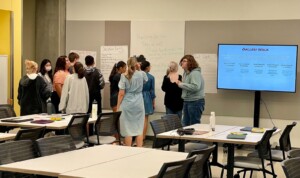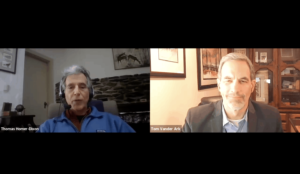An Education Innovation Discussion with Tom Vander Ark

By Rosie Clayton
It was very fitting that I started my Fellowship properly on Tuesday with a somewhat mammoth two-hour conversation with Tom Vander Ark, CEO of Getting Smart, covering a vast range of topics linked to the development of innovation ecosystems in education.
Tom writes prolifically about all aspects of education innovation and it was great to pick his brains and get a sense of the current education landscape in the USA and new innovation trends, as well as visit the Getting Smart ‘office’ (more of a house, which was slightly surreal) south of Seattle.
Below I’ve tried to synthesize the main themes of our discussion — which also raise a number of thought-provoking questions related to my research.
Innovation Diffusion
We started by discussing innovation diffusion, or lack thereof, in education, in comparison to other sectors and particularly the number of disincentives to innovate — accountability systems, political cycles and electoral dynamics, funding, system leadership. All of which have the potential to either suppress or spark innovation depending on the prevailing policy climate, and which currently lead to a high-risk landscape for educationalists. A very similar picture to the U.K.
He was optimistic about a number of emerging trends which are helping to de-risk innovation activity and diffuse innovative practice:
- Tech tools — and particularly online platforms giving rise to platform centric networks
- The funding climate, and intermediaries such as incubators and catalysts
- Microschools — in the context of new school development and bringing new ideas into the system
(And a key piece of advice for us U.K. educationalists: start working around the edges rather than going straight at the problem first, find the outcasts, then assimilate practice across settings. This is a timely piece of advice as I’ve spent a lot of time this summer thinking about SEND pedagogy and lessons for mainstream — more on this in a later blog).
System Trends
I posed a question around how measures of success in education are changing, partly prompted by a Skype conversation earlier in the day with another educator where we had discussed the move towards competency-based approaches, and career readiness, as college ready benchmarks and outcomes are proving inadequate with large numbers of graduating students dropping out of college, overwhelmed by the experience having followed a highly driven and scaffolded curriculum.
Tom agreed that the education system is moving towards the widespread adoption of broader aims, with more attention now being paid to social and emotional learning and mindsets, with some U.S. states now incorporating these competencies as part of graduation credits. Interestingly, in comparison to the U.K., digital literacy is not high on the agenda.
He highlighted Summit Public Schools as probably the most innovative secondary schools in the world right now, building a sophisticated outcomes framework which shapes all learning.
Working with Facebook and the CZI, Summit has developed a personalized learning platform — both as a school management and personalized learning tool — which is now freely available to all schools in the U.S. Linking to the above point about innovation diffusion, this is an important part of the strategy for both Facebook and Summit, as well as growing the number of Summit schools as exemplars of practice (hopefully I will get to visit one in California next week — or pick Tom Beresford’s brains later on in this journey).
With regards to career vs. college readiness, I asked whether college readiness will still remain the top system driver in the U.S. given these wider shifts — in the same way that University continues to dominate secondary and even primary education dynamics in the U.K. — and Tom felt that two main forces were now changing perceptions of readiness:
- Colleges (universities) now wanting better evidence of ability and potential (e.g., around a broader range of metrics) and many are now asking for portfolios of work and evidence of a wider range of learning experiences, rather than just academic grades which give a v narrow perspective. We discussed the huge opportunity here around Open Badges and micro-credentials.
- Career and Technical Education is experiencing something of a revival in the U.S. at the moment (similarities to the U.K. in terms of apprenticeships and the development of degree apprenticeships) due to the recognition that there are an increasingly large number of well-paid jobs in technical fields, and new opportunities emerging; the need to expand the diversity of post-secondary options; and the advent skills bootcamps which provide a flexible and intensive way to learn and gain skills.
There has also been a shift towards people accessing higher education at a later stage in their life/career, with competency-based education and credentials, badging towards industry certificates and nano degrees poised to revolutionize the potential to earn and learn, and provide a more dynamic way of evidencing skills.
All of these forces are challenging educators to think differently about skills and success. And it made me wonder, could a fundamental reconceptualization of higher education have a significant impact on the secondary education system? Especially as many employers (in the U.K.) are moving towards school/university/degree blind applications, favouring a variety of competency based assessments instead for recruitment. There is certainly a need for much more rich and diverse progression pathways, with flex across and within, reflecting learning as an evolutionary and creative rather than linear process.
Google vs. Facebook
I’m very interested in the role of the tech giants — Google, Microsoft, Facebook — in shaping education policy and practice in the USA, and we briefly discussed the difference in approaches and strategies/objectives of the different companies.
Tom felt that the main difference centered around pedagogy, with Summit and Facebook designing a platform tailored for a very specific and sophisticated learning model, combining playlists and projects and allowing students to have a set of individualized learning experiences (linked to the outcomes above). Whereas Google and Microsoft are developing learning tools with no pedagogical bias or specific outcomes in mind. An interesting distinction. And linked to scaling, for the Summit/Facebook PLP, fidelity to the model is clearly inherent, whereas Google tools may become more diffuse across the system, but low fidelity.
Both approaches support innovation diffusion and speed scaling — however, I do wonder about the desirability and effect of one or two tech organizations shaping pedagogy, rather than say having a multiplicity of industry voices contributing towards intended outcomes. And these companies are compiling huge data sets on learners and school systems which are of significant value. I’d be interested to find out if these will ever be openly available in the public domain, my guess is not. Networks thrive on the currency of data and ideas, one of the value flows I’m keen to explore further.
Networks+
Linked to platforms, we discussed how platform centric school networks will become an even bigger part of the future education landscape — a learning model supported by learning platform and a set of professional development services — likely to be a powerfully combined scaling strategy for school networks.
Another theme emerging from my trip so far has been the points of competition and collaboration between school networks — an important area for learning as we move to a system of Multi Academy Trusts as the main vehicle for education delivery in the U.K. I will post on this once I find out more.
Tom also highlighted the emergence of regional education ecosystems in the U.S. as key innovation tools — again a triangular approach combining a network of high schools moving towards proficiency-based education, state policy that supports proficiency-based diplomas, and public higher education institutions which recognize and also support this effort. These sort of regional partnerships fundamentally change the system dynamics creating a virtuous cycle — in shifting what colleges ask for in admissions, and changing the graduation requirements — which has dramatically reduced the barrier to, and risk of, innovation for school and system leaders. (See Tom’s book, Smart Cities that Work for Everyone.)
This poses an interesting question and potential opportunity in the U.K., thinking about the push toward regional devolution including of skills policy, elected mayors, and specifically in education, Regional School Commissioners as system brokers. The RSA is also doing some really interesting work around the concept of Cities of Learning.
VR/AR in Transforming Learning
Looking to the future, I asked Tom what he thought of AR and VR as learning tools — particularly as I’ve been doing some work on this over the last six months with mixed success, and also my own experiences of VR to date have been unimpressive. The headsets have generally made me feel quite sick and disoriented (but this is probably just me!).
Tom was more enthusiastic about the potential of AR, especially as a means of supporting learning in and around the community — as anyone who has played with Pokemon Go can attest to!
I fully agreed that it can allow you to experience your environment in a rich and immersive way, and with VR, we also discussed its potential for career and place-based learning — for example, the ability to ‘experience’ any place on the planet or any job in a greater degree of depth than say via a film.
However there can be no substitute for direct experiences — for example, with world travel where everything about the experience is challenging, you develop confidence and skills in navigating new settings and unpredictabilities and, perhaps most importantly, developing a sense of culturally fitting in and belonging in a globalized world.
AR/VR may become a weekly part of learning experiences in the future, but Tom felt that the technology was at least two years away from being cheap enough to make a difference. In any case, in learning and forming experiences and opinions, he felt that reading can perhaps account for 10%, video 20/30%, and VR 50% — a very useful distinguisher.
AI/Machine Learning
Beyond VR/AR the biggest challenge to existing systems and orthodoxy is likely to be AI and machine learning, with significant implications for education on many levels.
Tom described the potential direct impacts as improvements in adaptive learning, AI tutoring and back office school functions such as data analysis, student scheduling, transport scheduling and budgeting.
Virtual assistants are also likely to become a more prominent feature of educational experiences, providing academic support and helping learners manage their work more effectively. This reminded me of an ex-colleague of mine, now working at the London Design & Engineering UTC, who has recently ‘employed’ a robot teacher!
The more interesting puzzle, however, is what does this mean for education priorities and outcomes more generally, and the rapidly changing nature of the skills climate. Tom described the pressing need to introduce young people to novel and complex settings, to develop design thinking, problem-solving, team management and project management skills which produce useful outcomes, as well as confidence in the face of complexity and novelty.
This in part has motivated him and colleagues to switch interest from education policy to technology innovation, and the development of many more formal and informal learning opportunities as everyone becomes connected via smart technologies now coming into education markets, and a changing system where money will follow the learner in accessing a wide range of learning choices. Combined with the move towards competency-based education and credentialing skills, this hopefully also has the potential to expand access and equity.
We discussed the urgent need to upskill teachers and educationalists, and build in system-wide capacity — perhaps both through micro-learning and spaces for collective learning.
*As an aside, it’s interesting that pretty much all ed innovation discussions revolve around tech innovation, or are seen through the lens of tech — rather than other methods for innovation (e.g. cooperative learning systems). And we talk about developments in AI and machine learning as though this is some sort of inevitability, rather than actually a human/ people led endeavor, and assumed to be a ‘good thing.’
Economic Forces & the Gig Economy
Following on from and linked to this, we discussed the rapidly changing nature of employment and self-employment and implications for education and skills policy. It’s likely that innovation ecosystems will become increasingly important in moving student learning models from one system to another in preparation for developing the skills, and mindsets to move fluidly from situation to situation, project to project, through a future typical career.
Tom explained that one of the impacts of the U.S. presidential election has been the increased attention paid to inequality in society, and in a similar vein to Brexit, the realisation amongst policy makers that around 50% of the population have bought into and benefitted from globalisation, and around 50% have not and are looking for people to blame. It’s a gulf that is likely to increase rather than decrease as more people become alienated and dislocated by the automation economy.
(Thinking about the above point on AI and machine learning, I think there is a question here as to who is arbitrating the equity of technological transformations. And around the future role of Governments in pro-actively shaping markets rather than creating general conditions for enterprise and managing fallouts — see Mariana Mazzucato on inclusive growth.)
It’s therefore vital for politicians and policy makers to consider how as a society we support those in service economy, low-income and vulnerable jobs, and a guaranteed basic income offers one potential solution. It’s certainly a vocal movement which is developing across Europe — and in the U.K. through the work of the RSA, for example.
Also skills bootcamp style learning programmes, beyond coding, may prove instrumental here — and linked to the gig economy — in rapidly re-skilling workers in a low-cost, time-efficient and creative way to move from one sector or project to another.
Tom was also hopeful about innovation ecosystems in this context, highlighting that the creation of learning ecosystems tended to be a high priority for state mayors, who would otherwise need to be thinking about social service and welfare ecosystems. The question of how to support low-income families is not a theoretical exercise for them, they live and breathe it, and most Governors are also pragmatic, leading to healthier and more proactive regional conversations than at a national level. From my (limited) experience I would say the same is true for the U.K.
XQ Super Schools
We briefly discussed the impact of the XQ Super School competition — an extremely high-profile national school design competition — and its role in massively mobilising and energizing talent across the country, developing a national conversation around school design and innovation, and generating a huge number of new ideas, many of which are likely to proceed even without the grant funding. The process for many educators and school leaders certainly seems to have been transformational. We need something like this in the U.K.!
Wicked Problems
It was also interesting to get Tom’s perspective on where the greatest need for new education/skills thinking in the U.S. is — what the intractable problems/challenges are that no one has got close to finding a solution for yet:
- Early learning — closing the school readiness gap for low-income kids — which may require intensive and sophisticated academic and social interventions supported by youth and family services — and the development of better integrated service delivery models
- Tackling pockets of generational poverty which heavily impact on learning
- Better educating and providing pathways for young people in the criminal justice system, and foster care system
So…we covered a lot of ground!
And there are a number of questions and challenges for educationalists and policy makers which inevitably follow on, but there was one really huge and significant question which Tom highlighted.
It’s generally assumed that increasingly diverse and wide-ranging assessment and outcome metrics (e.g., Summit PLP and competency-based approaches) are a good thing, in providing better and more sophisticated evidence and analysis of achievement, capability and potential. And I have tended to agree.
However, will these increasingly complex metrics and measures of what counts as success exacerbate and widen existing achievement gaps rather than level the playing field and therefore entrench already existing societal inequalities. Competency-based education is already raising the bar, and the need to now develop social and emotional mindsets, computational thinking and critical thinking skills etc., could perversely add additional layers and barriers to accessing further education and employment opportunities throughout life.
A number of metaphors come to mind — including the law of unintended consequences.
For more, see:
- Hot: #OnlineLearning #MakerSpace; On the #EdTech Horizon: #VR, #AI
- Preparing Students for the Gig Economy, Automation and Uncertainty
- 10 XQ Super Schools Announced: Leading the Way in Rethinking High School
Rosie Clayton is a freelance consultant currently working across education, tech, school and network design in the U.K. She is exploring innovation ecosystems in education across the US as part of a Fellowship with the Winston Churchill Memorial Trust. Follow her on Twitter: @RosieClayton
This blog first published on Medium
Stay in-the-know with all things EdTech and innovations in learning by signing up to receive the weekly Smart Update.







0 Comments
Leave a Comment
Your email address will not be published. All fields are required.